
In conversation: Cinematographer Alagappan
Jul 07 2020
Cinematographer Alagappan N is the most accomplished award winning cinematographer in South India who predominately works in Malyalam Films. He worked for Doordharshan and went on to film landmark events of our country. Travelled with Great Leaders of India, he filmed more than 100 documentaries and also As a wild life cinematographer, his visual Journey is a rare phenomenon. He came back to do fictional feature films that are considered landmark films of Malayalam film Industry.
Alagappan also produced and Directed films in Malayalam. He shares his vast visual Experience with SICA.

Tell us about yourself and share about your journey as a cinematographer? We heard you have had a short stint at Television which got you much appreciations.
I think my journey of Images started off from my childhood days. I was born in Nagercoil which is amidst a lush green surroundings, full of beautiful ponds. My place (kanyakumari) has all the landscapes- sea, mountain, farm lands, coconut trees, cane lands, rubber estates and I have always liked the environment around me when i go out with my grandfather. My first experience with the camera was with Box Camera Agfa Click-3. I have taken an image of sunset from sand dunes as foreground and i think that was my first photograph. Though I was not aware of anything, the picture came out really well. I think, from the imagery I saw in my childhood and the environment had helped me unknowingly harnessing the aesthetics.
After finishing my Cinematography course at Adyar film institute, I started to assist with Cinematographers – Maruthi rao, JJ Vijan and Robert Rajasekar. At that time in 1979, television was emerging as a new media and I decided to work on television. I joined DD kashmir and worked for a short period and then I moved to DD Jalandar. With my fellow Cinematographer-friends Arumugham
Infact earlier i had done projects together with Arumugham. we established it in a new form. As a film institute student, from the training we had, we could create beautiful things particularly in terms of lensing and Composition and applying the elements of 5C’s of Cinematography had gained us much recognition and appreciations. From there I have travelled widely starting from News, Sports, Documentaries and Wildlife.
I have also worked for many fictions for television about great malayalam writers (like M.T. Vasudevan nair, K. Surendaran, Kunjabdullah) and even some sahitya akademi award winners & developed a close rapport with those writers. I have also done ‘Anna Karenina’ with all Writing, Direction & Cinematography and I have also done for about 100 documentaries. I think my journey in television was a beautiful and a wonderful experience. I also can proudly say that I have won 5 state awards continuously.
My career is more like a Zig-Zag and I am very much proud to say that I like to explore new things in my Life.
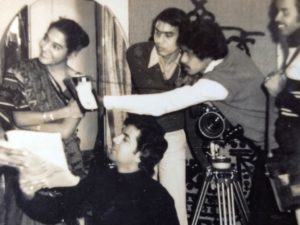
You have working experience in News with many renowned personalities. Share some interesting experiences.
I feel very privileged that I have travelled with great personalities like Indira Gandhi, Rajiv Gandhi and even travelled for a year with President K.R. Narayanan. It was an interesting experience for me and while doing the coverage, I not only cover the news , in addition I also cover few shots about the backstory of it too. I think the ‘filmmaker’ in me urged me to do that and I used to arrive at the spot- an hour before, to shoot the back stories of the event. Specifically, those got me many appreciations & one such was for a tele film called ‘Chitta log’ aired in Punjab Television. I was appreciated and even people from Pakistan calling the channel to show the Cinematographer of the film. Though initially the makers didn’t call me for the program, after frequent messages from people, I was called to participate in the program. It was an endearing moment of my life.
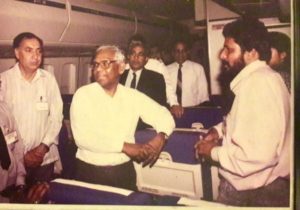
Heard you even covered an accidental Bomb blast that happened on Independence day celebrations shoot?Could you tell us about that ?
Yes, it was one heart-wrenching shoot of a Bomb Blast in Ludhiana. I was deputed to cover the Chief Minister’s Independence day celebrations. I was about to start the coverage and when the chief minister was nearing people, suddenly one person got over the top of the chair and threw a hand grenade over the public. People and police were terrified and started running all over. Suddenly I took the camera shooting the incident covering the people and unfortunately, i was having only a 200 feet loaded magazine, so i have shot only the important shots. Those moments were really panicking and with the running crowd I was pushed over the gutter on the ground. I knew that would happen, so I made the lens wide and I even covered the person who threw the grenade. Some were haunting shots, particularly the shot of a Photographer who was running with his back completely ripped and a person who was taking his own eyes on his hand. Finally I was left 25 feet and wanted to use it wisely. So, I decided to cover up the wounded patients in the hospital in glimpses.
I still remember those moments and memories are haunting me for a long time. But as a cinematographer I feel proud I could deliver the best amidst the panicking situation.
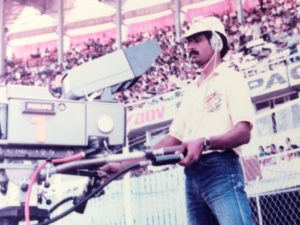
You have covered World Cup Cricket & Tennis. Can you share your experience in it?
I have covered 5 matches of World Cup Cricket and it was a very big opportunity. It was headed by a BBC trainer who is also the producer of the event and has 20 years of experience in television programmes. Initially 100 people were shortlisted to cover the match and I was one amongst them. They conducted a physical fitness test for us and shortlisted 50 people from us and gave training. After the final training they shortlisted 30 cameramen and I was one among them. It was again a challenging one and we have got 6 cameras to shoot the match and one camera was wireless to shoot the audience and for VIP’s. We used the Ikegami-Philips camera and it has the range upto 1000mm. We had a rack focus system and the camera has a focus option for the left hand and you should change the focal length in the right Hand. It was physically challenging shoot as we need more stamina to stand long and shoot for longer hours.I also covered the World Cup Tennis tournament and I have gone for a special training for the shoot.

And you shot the infamous ‘Operation Blue star’. Could you share your experience of it ?
Yes.It was a big operation by the Government of India under the leadership of the then Prime Minister Indira Gandhi. It was the operation of targeting a large bunch of the terrorists hiding in Golden Temple. My fellow cameraman Chandrasekar and I were deployed to cover it. It was a very proud and challenging shoot for a news cameraman which demanded the highest endurance and timing sense. We, along with the army men were covered by terrorists attacking in 270 degree and we could only cover hiding behind the pillars. I was carrying a 16mm Eclair CP 16 camera with reversal films and a sony camcorder. Since we would be running randomly we could not afford to get camcorders which were cumbersome at that time due to its battery size. Thus I have settled with one eclair and one camcorder for the coverage. The operation was painful and life-threatening with rain of bullets pouring all over and even a small bullet could lead you to death. Despite that, I was energetic and as a filmmaker I was able to record the challenging shots.
We were running bare legs over drenched blood as we were not allowed to wear shoes inside Gurudwara. We shifted places when there was a halt and since the place was dark we were shifting places by hearing the breath of soldiers. I remember a moment when one of the soldiers asked us to move away as it was the near end death situation and I replied “I would love dying happily for my country”. He smiled and we shot continuously & it was a proud victory for Indian military under the leadership of the then Prime Minister Ms. Indira Gandhi.
Could you share an incident you mark as a Turning – Point in your life ?
I feel a lot of interesting turning points happened all through my career. After joining first year of my institute, I happened to visit the location of Cinematographer B.Kannan’s film. While I was waiting, Kannan sir asked me to come inside the set and I felt that was the first motivation point in my film career. Later, I assisted many of my institute seniors and once I assisted Cinematographer Robert Rajasekar for a film (‘Kudisai’) Directed by Mr. Jayabharathi. It was a night shoot and at a point, Robert sir asked me to operate the camera. I was shocked and I was in my teens then. Even director Jayabharathi questioned whether I can shoot? He replied that I will do and I have done about 15 shots at that shoot and it is one of my turning points.
Another interesting experience was when I was assisting Cinematographer Maruthi Rao. At that time I was working with him in ‘Unnai Vida Matten’ starring Puratchi Thilagam MGR. I was very excited to work for his film and once in a scene I was handling a camera on my shoulders to capture his live moments. Mr. MGR questioned, ‘can you handle the camera without shaking’ and I replied “I will not make the camera shake even if i fell down to death sir”. I was completely perplexed until the preview or rushes happened at old Gemini theatre. After the preview, Mr. MGR just tapped my shoulders and went. I was in total shock and awe as I was not sure whether he liked or did I make any mistakes? At last, Maruthi Rao sir told me I didn’t do any mistake and Mr. MGR liked the sequences. It was one of my happiest moments in my life.
Likewise I have had many occasions in my life and all my seniors have helped me to grow. For a period, I wasn’t working in films and working for advertisements. On one such shoot, one producer happened to visit me and recollected he likes the cinematography of a short I did for a Television. I was quite surprised, he has seen all my television shorts and to my surprise he said I am the cinematographer of his next film. The film was the biggest turning point in my career and the film I got was ‘Nandanam’.
Interesting. And nowadays the Cinematography of Malayalam Cinema has got a unique style and making. What are the challenges you face and how is your working process when you start a film?
I feel cinematographer’s role is the most important in film making, because he needs to coordinate with the director, actor, Art-director, costume designer and mainly the producer as we need to understand the budget of the film. Malayalam films work in a different way than Tamil cinema and its budgets are different. I have worked in all kinds of films, like Chinatown, Prajapathi, which were high budgeted and also have worked in Ozhimuri, Kaazhcha, Thalappavu Uncle which were medium budgeted. I feel ‘homework’ is the most important thing to work on for any budget film. We always should see how to bring in the same quality for both films so we can achieve this from a proper learning. That is why I feel a proper film learning in a film school is needed and we first learn and then we do. I feel ‘learning first & then doing’ is better.
And I always ask who is the art director first before asking the actor of the film. i feel the colour of my film is most important and I always change the colour palette of my film.I also give more concentration about the colour of costumes and even for my new film ‘Vardhamnan’ with Siddhartha, Actress – Parvathy Thiruvothu is the lead actor of the film. I voluntarily went with her to purchase the costumes in Delhi for the film.I feel my background and its colour are very important and doing such things will avoid confusions on the shooting spot.

Do you have any specific form of lighting style you follow and do you have any specific colour scheme you work?
Personally I don’t like primary colours and I like to work on complementary colours & specifically more greens. I love to work with forest, wild, and bright greens in my films. Even once I was referred as Village Cinematographer after working with many village subjects. I like to work with whites, blacks and use low-key key lighting a lot and mostly prefer naturalistic style of lighting. To say, for a song (Enikkoru Pennundu) in the film ‘Thilakam’, I used one colour for the background, costumes and props. Though initially the film’s Director Mr. Jayaraj was reluctant about the thought, I showed him a Photograph in FUJI film brochure which had a yellow colour scheme with clear separation of background, props & model. Director Jayaraj agreed to do it and I shot as planned. The song was a big hit in the malayalam film industry at the time and gained me accolades.
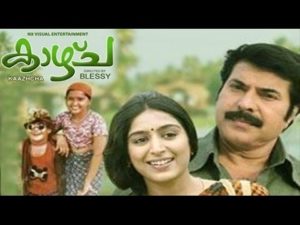
‘Kaazhcha’ was undoubtedly one of your best films. Could you share something about the film ?
Kaazhcha was the first film of director Blessy and it had the story backdrop on ‘Gujarat Earthquake’. When initially Blessy narrated the story, I was really excited about the project because of its story and even Shri Mammootty accepted to do the role after listening to the story. It was a medium budgeted film and I know we couldn’t afford to get more lights & at that time, the highest speed of the film was 400 ASA. There were more night sequences in the film too. So, I decided to do the push processing and we did in Prasad Labs under the guidance of Mr. Sivaraman. Mostly I have used baby lights and relied mostly on natural light. We have used large bounce boards, white cloths for diffusions and at times we collate many torch lights to bounce the light off from the board.
But, how did you achieve the grandeur of the film ?
We know the limited light resources and I felt composition & lenses were the areas I needed to play. I used largely wide lenses and we wanted to shoot more ‘panoramic’ kinds of shots. We tried to show the camera from the bird’s eye view perspective. During the recce, I gave the camera to a tree-climber to click the image from the height of a tree, to check its perspective. From the point of view, Alleppey was beautiful to look at. We hired a 40-feet crane for a few days and used rope to shoot other handheld shots. We have used top angles a lot and have used mostly 40-50mm as the lens range & completely avoided tele and zoom lenses. And for the Gujarat portions we completely shot in natural light using large bounce boards.
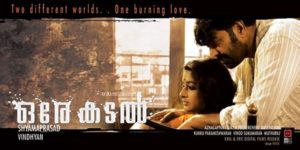
Nice. Regarding your film “Ore Kadal ”, it’s another classic having more intimate sequences happening in closed rooms. Tell us your experience about its making.
Yes, it is a script of minimal people having a lot of emotions happening in closed rooms. The story backdrop is Visakhapatnam happening near the beach. We couldn’t go to the real location and we erected the house setup with a couple of rooms- in Parsn Complex Chennai. Art-director Muthuraj erected the set. I have installed some jewellery lights to have illumination and used ambient window light bounced, to get more for the fills. Since the story is happening near the beach, we have used Fan and blowers to move the window screens and the change of light & shade , created a realistic feel. Myself & Director Shayama Prasad even visited the set before the shoot and observed the flow of light in the rooms from morning to evening. Accordingly we’ll schedule and shoot the scenes to get maximum illumination. More than all we didn’t require much light for the story as it was a doomed life of a people. We have shot the film in 28 days and out of which 24 days were indoor shoot.
We also used some wind noise to add the liveliness to the story and I often work on the sound part in all my films. I feel this helps the audience to connect with the place or the venue where the scene is happening. I always visit the locations in advance so that I will see the possibility of sounds we can add for the scene, so that I can avoid confusion while we shoot.
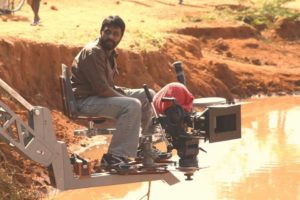
Very Interesting. ‘Irumbu kottai Murattu Singam’ was one of the different Cowboy films in Tamil cinema and it got much appreciation for your camera work. Share us your experience in it.
I have always wanted to do cowboy films, after seeing the films like ‘Mackenna’s gold’ and ‘Good,Bad & Ugly’. Once I heard the story from Chimbudevan I immediately agreed to do the project. Though it was a Cowboy film it had a strong political element and we felt a good art direction will only do justice to the story. We called Art-Director Muthuraj for the film and we had a wonderful team to work. I have used more wide angle lenses for the film, to create dynamic perspective and even have used 8mm for some horse portions. Sometimes i will say the actors not to move ‘degrees’ when using 12mm as it may make the faces distorted. It was a wonderful experience working for the film
film.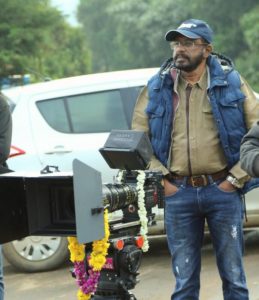
How do you approach the story as a Cinematographer ? How will you start the work?
I always believe cinematographer has to deliver the visuals based on its story line. Whenever i receive the story i first divide the story into two- one its literary value & second its visual value. I always ask the directors to tell the story twice, even ask them what kind of colour, lensing and movements they want in the film. I prepare a separate storyboard for myself and ask maximum information about the story, characterisation ,screenplay. I always insist the director to narrate the story fully and then I will ask the associate directors so that I want to listen to what the director thinks and if I read first without him I may get driven by my own style of visuals.
On one strange occasion for about 140 days & I had to shoot the same house for 4 different films. The biggest challenge is I shouldn’t make the audience feel it is the same house in all 4 films. So I request the directors to avoid the angles, lenses and the lighting I used in the previous film and I will follow a new scheme. Thus we would be getting a new visual scheme altogether.
I have been always trying to do every film with different styles of works and once they even addressed me as an art film cinematographer. I wanted to break that stereotype when i got the film Chinatown- a fun filled film, in which i have used mexican colours and extensive zooms shots which i never tried in my earlier films.
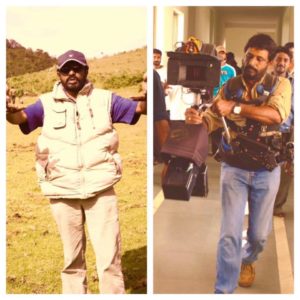
How do you see the recent criticism that all the films in the last few years don’t have a distinct style of Cinematography ?
I feel youngsters are habituated to see the visuals in monitors. I have the habit of not seeing the monitors and I feel, as cinematographers, we need to visualise for the big screens. And now most of them are working on lower fno’s and I feel the film lacks the depth of field and they see, frame and work with monitors. I think these may be the reasons for similar or no different visuals, as we see in TV’s.
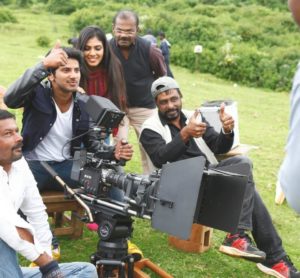
What is your thought about the Post-Process in the Digital era? How do you work and how much do you rely on the Post-Process in the visuals?
I think I belong to a generation of pre-conceived,planned cinematography. I think it works on eye judgements and it is a more psychological thing. For the film ‘Nandanam’- based on the script, I have made sure that every frame has small blue, to represent the colour of lord Krishna connect. I think I will always assure these things when I compose in my eye-piece itself. More than that i see these advanced post-processing advantages are only meant for image enhancements- not for image rectifications.
Very true. What are your principles and what are your regular practices to sustain in this industry ? Also, what is the advice or tip you would like to give the upcoming young cinematographers?
The most important thing is we need to fight for ourselves internally to do better things in every successive step and I strongly believe the principle of ‘work is worship’. For the upcoming budding cinematographers I urge them to practice dedication, sincerity and honesty in their thoughts and proceedings. Also, Just like we study 5C’s of Cinematography, i would like to introduce 5 W’s-
Why are you doing this ?
What are you doing this for?
To Whom are you doing this?
Where are you going to show this?
Who is your audience?
I insist every cinematography aspirant to question these things in mind before they plan for a shoot.
Cinematographer Alagappan is known for his friendly nature. He said during this lock down he has listened to at least 40 screenplays from upcoming film makers. In that, he may work as a Cinematographer for a few films. For others, it was purely script doctoring for their travel in the industry.
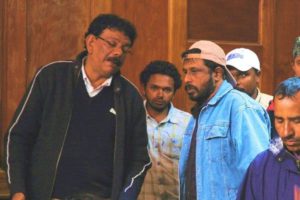
AWARDS
- Awards for Best Cinematography for Movies
- Kerala State Award for Best Cinematography 1998 – Film – Agnisakshi (1999 film)
- Kerala Film Critics Association Award for Best Cinematography 1999 – Film – Agnisakshi (1999 film)
- Mathrubhumi-Medimix Award 2000 for Best Cinematography 2000 – Film – Vasanthiyum Lakshmiyum Pinne Njaanum
- Kerala Film Critics Association Award for Best Cinematography 2002 – Film – Nandanam (film)
- Mathrubhumi-Medimix Award 2000 for Best Cinematography 2002 – Film – Nandanam (film)
- Asianet Award 2004 for Best Cinematography 2004 – Film – Kaazhcha
- Vanitha Award 2006 for Best Cinematography2006 – Film – Rasathanthram
- Mathrubhumi Award 2006 for Best Cinematography 2006 – Film – Rasathanthram
- Kala Keralam Award 2006 for Best Cinematography 2006 – Film – Rasathanthram
- Malayalam Movie Award 2007 AMMA held in Dubai for Best Cinematography 2007 – Film – Ore Kadal
- Jeevan TV film Award 2007 for Best Cinematography 2007 – Film – Photographer (film)
- Film Critics Award for Best Cinematography 2007 – Film – Ore Kadal
- SICA Award for Best Cinematography 2007 – Film – Ore Kadal
- Film Critics Award for Best Cinematography 2012 – Film – Ozhimuri
- Awards for Television
- Kerala State Government Awards for Best Cameraman
- Onida Pinnacle National Awards for Best Cameraman
- Nilavariyunnu – 1995
- Centre for Media Studies Awards for Best Cameraman
- Maratam Durbalam – 1997
- Film Critics Awards for Best Cameraman
- ANNA – 2000
- Kerala State Television Awards for Best Director
- ANNA – 2000
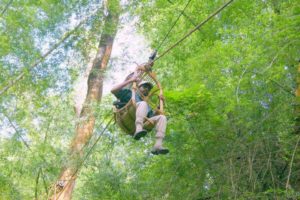
Drafted by Gowri Shankar
Conversation Concept by CJ Rajkumar & Mahesh Muthuswami
